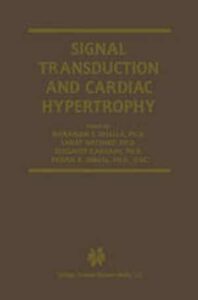نام کتاب: Signal Transduction And Cardiac Hypertrophy
نویسنده: Florian Grabellus و Bodo Levkau و Hans-H. Scheld و Atsushi Takeda و Michael Erren و Naranjan S. Dhalla Phd و Md Hon و Dsc Hon و Larry V. Hryshko Phd و Elissavet Kardami Phd و Pawan K. Singal Phd و Dsc
ویرایش: ۱
سال انتشار: ۲۰۰۳
کد ISBN کتاب: ۹۷۸۱۴۶۱۳۵۰۳۲۳, ۹۷۸۱۴۶۱۵۰۳۴۷۷, ۰۷۹۲۳۸۱۰۵X, 0792381475, 1402070527, 1402071779, 1402071957, 140207218X,
فرمت: PDF
تعداد صفحه: ۵۰۸
حجم کتاب: ۱۴ مگابایت
کیفیت کتاب: OCR
انتشارات: Springer Us
Description About Book Signal Transduction And Cardiac Hypertrophy From Amazon
Cellular signaling in cardiac muscle refers to the myriad of stimuli and responses that direct and control the physiological operation of this organ. Our understand ing of these complex signaling cascades has increased dramatically over the past few decades with the advent of molecular tools for their dissection. Moreover, this infor mation is beginning to provide tangible targets towards manipulating cardiac func tion in the setting of cardiovascular disease. The mechanisms and factors that regulate cardiac cell growth are of particular interest as both adaptive and maladaptive responses can occur during cardiac hypertrophy. Cardiac hypertrophy describes the increase in individual cardiac myocyte size that is accomplished through the series and/or parallel addition of sarcomeres. The ability of cardiac muscle to increase in size through hyperplasia becomes highly restricted or negligible shortly after birth. Consequently, the increase in heart size associated with development and growth of an individual occurs through hypertrophy. In response to a chronic increase in workload, cardiac muscle cells can dramatically increase in size to face their increasing contractile demands. While this plasticity is clearly a ben eficial response under many conditions, it can be highly deleterious and inappropri ate under others. For example, cardiac hypertrophy associated with endurance exercise clearly enhances athletic performance. In contrast, the hypertrophy associated with chronic hypertension, stenotic or regurgitant heart valves, or following a myocardial infarction often continues far beyond the period where this adaptive response is ben eficial.
درباره کتاب Signal Transduction And Cardiac Hypertrophy ترجمه شده از گوگل
سیگنالینگ سلولی در عضله قلب به تعداد بیشماری محرک و پاسخ گفته می شود که عملکرد فیزیولوژیکی این اندام را هدایت و کنترل می کند. درک ما از این آبشارهای سیگنالینگ پیچیده طی چند دهه گذشته با ظهور ابزارهای مولکولی برای تشریح آنها به طرز چشمگیری افزایش یافته است. علاوه بر این ، این اطلاعات شروع به ارائه اهداف ملموس برای دستکاری عملکرد قلب در زمینه بیماری های قلبی عروقی می کند. مکانیسم ها و عواملی که رشد سلول های قلبی را تنظیم می کنند مورد توجه خاص هستند زیرا هر دو پاسخ انطباقی و ناسازگار می توانند در طی هایپرتروفی قلب رخ دهند. هیپرتروفی قلب افزایش اندازه میوسیت قلبی فردی را توصیف می کند که از طریق سری و یا افزودن موازی سارکومر انجام می شود. توانایی عضله قلب برای افزایش اندازه از طریق هیپرپلازی ، اندکی پس از تولد بسیار محدود یا قابل اغماض می شود. در نتیجه ، افزایش اندازه قلب همراه با رشد و نمو یک فرد از طریق هایپرتروفی رخ می دهد. در پاسخ به افزایش مزمن حجم کار ، سلولهای عضلانی قلب می توانند به طور چشمگیری اندازه خود را افزایش دهند تا با تقاضای انقباضی فزاینده مواجه شوند. در حالی که این انعطاف پذیری در بسیاری از شرایط واکنشی موثر است ، اما تحت شرایط دیگر می تواند بسیار مضر و نامناسب باشد. به عنوان مثال ، هایپرتروفی قلب همراه با ورزش استقامتی به وضوح عملکرد ورزشی را افزایش می دهد. در مقابل ، هیپرتروفی مرتبط با فشار خون مزمن ، دریچه های استنوتیک یا عقب انداختن قلب یا متعاقب سکته قلبی ، غالباً فراتر از دوره ای که این پاسخ تطبیقی مفید باشد ، ادامه می یابد.
[box type=”info”]![]() جهت دسترسی به توضیحات این کتاب در Amazon اینجا کلیک کنید.
جهت دسترسی به توضیحات این کتاب در Amazon اینجا کلیک کنید.![]() در صورت خراب بودن لینک کتاب، در قسمت نظرات همین مطلب گزارش دهید.
در صورت خراب بودن لینک کتاب، در قسمت نظرات همین مطلب گزارش دهید.

